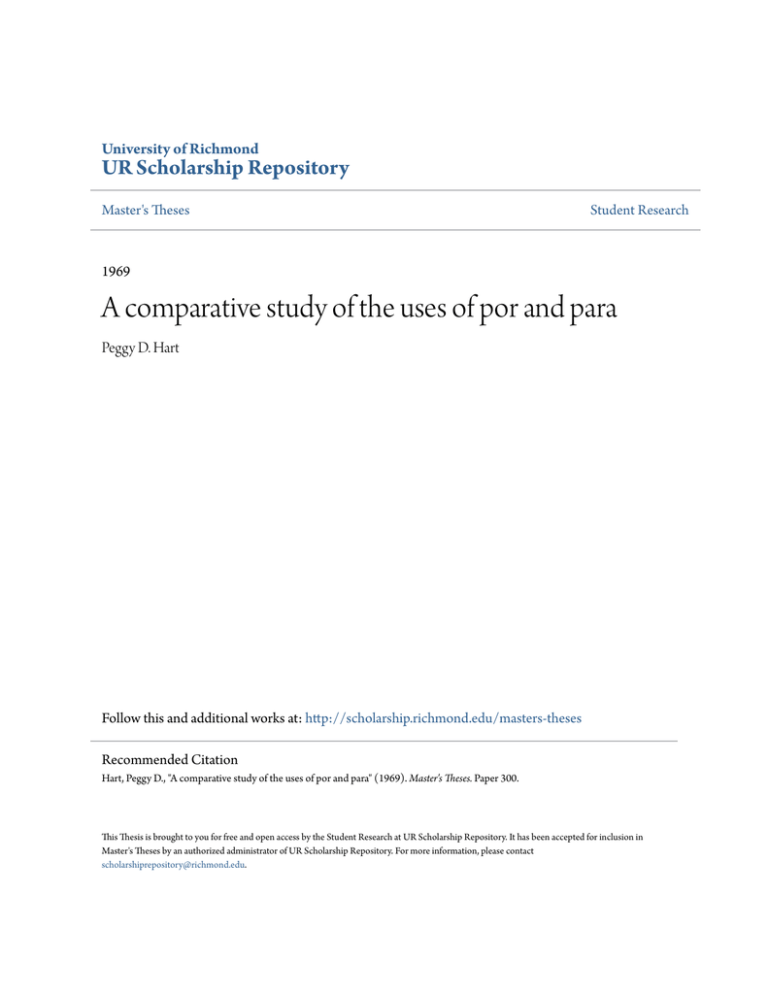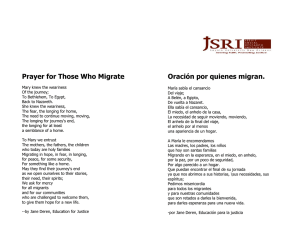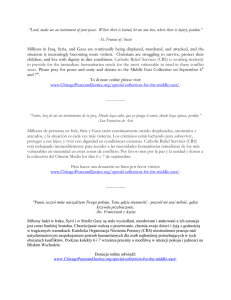A comparative study of the uses of por and para
Anuncio

University of Richmond UR Scholarship Repository Master's Theses Student Research 1969 A comparative study of the uses of por and para Peggy D. Hart Follow this and additional works at: http://scholarship.richmond.edu/masters-theses Recommended Citation Hart, Peggy D., "A comparative study of the uses of por and para" (1969). Master's Theses. Paper 300. This Thesis is brought to you for free and open access by the Student Research at UR Scholarship Repository. It has been accepted for inclusion in Master's Theses by an authorized administrator of UR Scholarship Repository. For more information, please contact [email protected]. A COMPARATIVE STUDY OF THE USES - OF POR AND PARA A Thesis Presented to the Faculty of the Department of Modern Foreign Languages University of Richmond In Partial FufFI I fment of the Requirements for the Degree Master of Arts by Peggy D. Hart June 1969 L!BR/',R't UN!VE.RSITY (')F RICHMOHi'.l APPROVED FOR THE DEPARTMENT OF MODERN FOREIGN LANGUAGES AND THE GRADUATE SCHOOL ~'h - I I- " Readeof Thesis /] ~, ) Reader ofheSf s ~ Q~;;r ~ zL-----" CONTENTS Introduction • • • • • • • • • • • • • • • • • • • • I. Historical development of 12.2.!:. and para • • • • • 3 A. Latin prepositions rendering e2.!:. •• • • • • 3 $ummary Chart • • • • 6 a. II. Latin prepositions rendering para •• • • • • 7 Summary Chart • • • • 8 Uses of the English prepositions A• B. .f2!:, 2,y_, and through. • • • • • • • • • • • • • • • • 9 .fE.r... • • • • • • • • • • • • • • • • 9 Summary Chart • • • • " Use s o f Uses of E,y_ • • • • • • • • • • • • • • • • • II Summary Chart • • • • 13 c. Ill. Uses of through. • • • • • • • • • • • • • • f3 Summary Chart • • • • 14 Uses of E.2!. and para given in Spanish grammar books • • • • • • • • • • • • • • • • IV. f5 A. Para ands. • • • • • • • • • • • • • • • • • 15 B. Para and hasta • • • • • • • • • • • • • • • 16 C. Para or no preposition • • • • • • • • • • • 20 Uses of £2!. and para • • • • • • • • • • • • • • 21 A. Common misconceptions. • • • • • • • • • • • 2I Summary Chart • • • • 22 B. Temporal expressions • • • • • • • • • • • 23 Summary Chart • • • • 27 c. Spatial relationships • • • • • • • • • • • • 27 Summary Chart • • • • 31 D. With infinitives • • • • • • • • • • • • • . 3' Summary Chart • • • • 36 E. Para to express purpose, goal, or use. • • • 37 Summary Chart • • • • 40 F. £2.!: and para with people as objects •• • • • 40 Summary Chart • • • • 42 G. Agent or means • • • • • • • • • • • • • 42 Summery Chart • • • • 44 H. To fetch • • • • • • • • • • • • • • • • • • 44 I• Special uses of 12.2!:..• • • • • • • • • • • • • 46 I• Mathematical expressions • • • • • • • • 46 2. Exchange • • • • • • • • • • • • • • 3. Measure. • • • • • • 4. Series • • • • • • • • • • • • • • • • • 48 • • • • • • 47 • • • • • 48 Summary Chart • • • • 50 J. Other uses of por. • • • • • • • • • • • • • 50 I. In favor of •• • • • • • • • • • • • • • 50 2. However. • • • • • • • • • • • • • • • • 51 Judgment • • • • • • • • • • • • • • • • 51 Conclusion • • • • • • • • • • • • • • • • • • • 52 3. v. Summary Chart • • • • 54 _,_ INTRODUCTION Most experiences with textbooks have led me to the conclusion that .l2E!:. and para have not been given sufficient treatment in that these textbooks fai I to show enough of the contrasts between English and Spanish usage. Spanish grammar books, that is books written for native speakers of Spanish, are of little help since they assume that their readers are already aware of the differences. The purpose of this paper is to compare the Spanish prepositions Q.2£_ and para with the objective of developing a relatively effective approach to the teaching of these prepositions to native speakers of English. Many texts written especially for English-speaking persons who are learning Spanish, lack sufficient examples and frequently deal in generalities largely because of the limitations of time and space avai fable in textbooks. Some of the more thorough textbooks such as Ramsey, Bolinger, and Brett give a fairly comprehensive view of the uses of E.2!:. and para but tend to categorize and synthesize in an effort to save space and simplify instruction. The result of this simplification is that the student very often finds himself with a sentence which does not compare with the sample sentences given him in the text. While no attempt has been made to expand each use of E.Q!.. or para to offer the student a large number of similar 2 sentences for practice purposes, it is hoped that this paper might serve as a relatively complete guide to the various uses and distinctions offered by .esu:. and para, and that it might serve as a point of departure for the development of contrastive dri I Is and exercises designed to give the student an intuitive grasp of the prepositions. The conclusions reached in this paper are a synthesis of a careful investigation of a wide sampling of examples taken at random from various Spanish textbooks, literary works, periodicals, and from a number of native Spanish speakers from Chi le, Cuba, Puerto Rico, and Argentina. The table of contents also serves as an outline of the paper and thus facilitates the location of certain uses of 2.2£. and para. Wherever possible, a chart has been included to summarize uses as they are introduced. 3 I. HISTORICAL DEVELOPMENT A. 9£. POR AND PARA. Latin prepositions rendering The Latin preposition Spanish Q.2!.. while the Er..Q. £2!.·' etymologically yielded prepositions~' propter, and ob were replaced in Spanish by 2..2!..• Latin Prepositions Pro > Per> Propter · Por Por Ob I. ~was used to express: a. Space through or along which something passes. Example: Per membranas oculorum cernere. (Cicero) To see through the membranes of the eyes. b. Time through or during which something takes place. Example: Per noctem carnuntur sidera. (PI i ny} Stars are seen throughout the night. c. Agent instrument or means through or by whom something is cbne. Example: Per exploratores Caesar certior factus est. (Caesar) Caesar was informed by the scouts. 1Ar I the Latin examples for the prepositions~· E!.£., propter, ob, ad, and~' are from~ Latin Dictionary by Charlton T. Lewis and Charles Short (Great Britain, 1955). 4 d. 2• Reason, cause or inducement for an action. Example: Per metum mussara. (Plautus) To speak softly because of fear. .!:!:£?.was used to express: a. The place before or in front of. Example: Sedans pro aede Castoris. (Cicero) Sitting in front of the temple of Castor. b. For, in behalf of, in favor of, for the benefit of. Example: Veri inveniendi causa contra omnla dici oportere et pro omnibus. (Cicero) For the sake of finding truth and for the good of all, it is opportune that everything be said. c. Replacement, substitution, in the place of, instead of. Example: Ego ibo pro te, si tibi non tibet. (Plautus} I shall go in your place, if you do not wish to go. d. like, as good as. Example: Pro damnato esse. As good as condemned. e. On account of, for the sake of. Example: Dolor pro patria. (Cicero) Sorrow for the sake of the country. f. According to, in comparison with. Example: Meus pater nunc pro huius verbis recte et sapienter facit. (Plautus) My father now acts wisely and correctly in accordance with this one's words. g. By virture of or authority of. Example: Quia pro imperio palam lnterfici non poterat. (Livius) Because he could not be ki I led openly by virtue of his command. (Cicero) 5 3. 4. Q!?. was used to express: a. Towards or to. Example: Ob Romam legiones ducere. (Ennius) To lead the legion towards Rome. b. About, before, in front of, over. Example: Lanam ob oculum habere. (Plautus) To have wool in front of ·the eye. c. The object or cause of an action. On account of, for, because of. Example: Etiam ob stultitiam tuam te tueris? (Cicero) Do you sti II defend yourself because of your fol ty? d. In consideration of, in return for, instead of. Example: Talentum magnum ob unam fabulam d~tum esse. (Cicero) A great talent to be given in return for one single tale. Propter was used to express: a. On account of, by reason of, from, for, or because of. Example: Parere legibus propter metum. (Cicero} To obey the laws because of fear. b. Through, by means of. Example: Propter quos vivit. (Cicero) Through whom he lives or to whom he owes his life. 6 Latin prepositions rendering .f?.2!:• I. Space 2. Time 3. Agent 4. Reason I• Place 2. In behalf of 3. Replacement 4. Equa I ity 5. On account 6. Comparison 1. By virtue of I. Towards 2• I n front of 3. Because of 4. In return for I. Because of 2. Means Per Pro Ob Propter 7 B. Latin prepositions rendering para. ~. which in old Spanish was pora, and in modern Spanish is sometimes "en la pronunciacicfn descu i dada" 2 Examples: ~. a) evo I ved from Latin Q!:2. p I us ad. Et val lor pora todos tiempos. (Estatuto de la Aljama de Zaragoza, ano I 331) b) ~Pa dO'nde son las fotograf (as? (Goytisolo) c) La qual pena sia por al sennyor Rey. (Estatuto de la Aljama de Zaragoza, aiio 1331) Pro ) por por +a> pora > para Joan Corominas states in his Diccionario etimof~gico that para appeared in 1250 and that it was probably an alternation of pora which was made E2!:. and A• from This alternation was facilitated by the in- fluence of the old Di cc i onar i o up preposition~· ~... Autor According to the i dades, para Is used to rep I ace the Latin ad and a I so Latin wt. - - I. Ad was used to mean: a. 2 I Direction toward, to. Example: fu9ere ad puppim col les campique virdentur. {Lucretius) The hi I Is and fields appear to ffy toward the ship. I I • I Ramon Menendez Pidaf, Manual de gramatrca historica espanola (Madrid, 1966) p. 338. 8 2. b. The point or goat at which anything arrives. Example: Litteras dare ad aliquem. (Cicero) Send a letter to someone. c. About, up to, unti I. Example: Domum reductus ad vesperum. (Cicero) Led home about evening. d• In order to Example: Venimus coctum ad nuptias. (Plautus) We come in order to cook for the wedding. J:!l was used to mean: a. Considering ••• that, in accordance with. Example: Epicharml, acutl nee insulsi hominis, ut Sicull. (Cicero) ••• considering he was a Sicilian. b. In order that, so that. Example: Reliquum judicium de judlclbus, et, vere ut dlcam, de te futurum est. ·(Cicero) ••• to te 11 the truth f• Direction 2. Goal 3. Toward 4. In order I• Considering that 2. In order that Ad .)>ut 9 I I. USES OF!.!:








